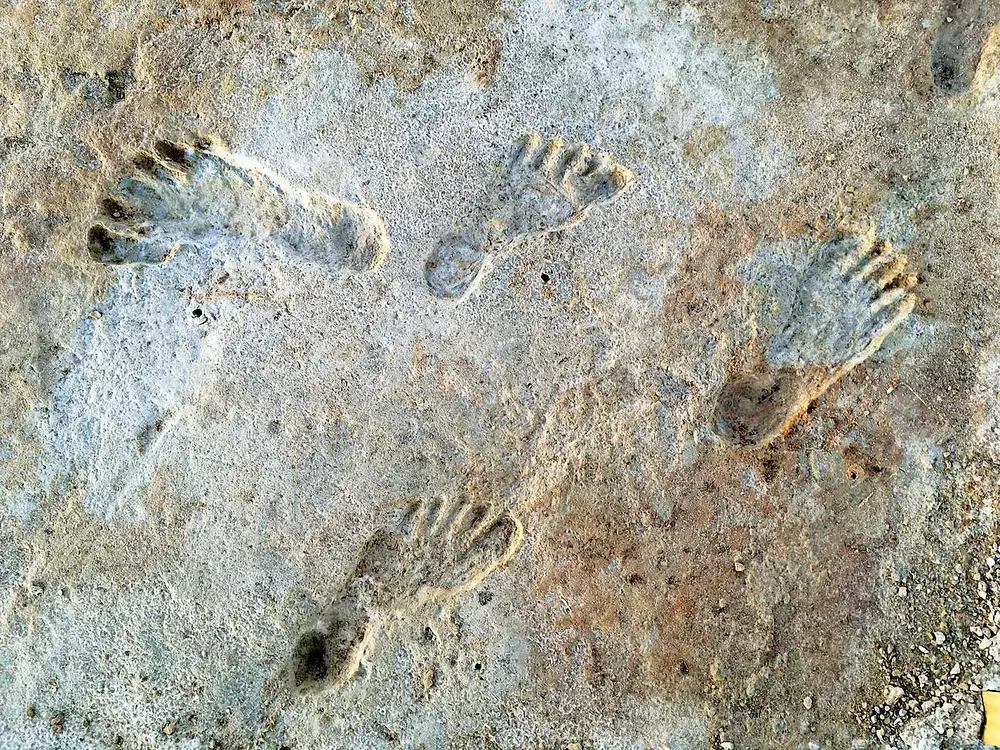
Tracking Humans’ First Footsteps In North America
At a site in New Mexico, a new discovery rewrites the human history of the continent.
By: Richard Grant | Smithsonian
Ancient human footprints, preserved in a dry lakebed at White Sands National Park in New Mexico, reveal remarkably vivid vignettes of life in the late Pleistocene: children jumping in puddles and splashing, a group of hunters stalking a giant sloth. The scientists studying these footprints initially estimated their age as between 11,500 and 13,000 years. But now, radiocarbon dating has allowed experts to make a bombshell discovery: The oldest of these footprints are nearly 23,000 years old.
For many decades, archaeologists were convinced that the first people to arrive in the Americas came some 13,000 years ago, after the Ice Age glaciers melted. The White Sands footprints, whose age scholars estimated again, in a paper published this past October, by analysing tree pollen and quartz grains in the sedimentary layers, provide the most conclusive evidence to date that humans were actually here much earlier, toward the end of the last ice age. It’s possible that they reached North America more than 32,000 years ago.
Now, “we need lots more sites to make sense of where they came from and by what route,” says Matthew Bennett, a professor of environmental and geographical sciences at Bournemouth University in England and lead author of two scientific papers about the footprints. “The lasting legacy of White Sands is to point the way to a new archive of evidence.”
The footprints were made by people walking on damp ground at the edge of a lake. Some are visible to the eye; others can only be found by ground-penetrating radar. Bennett knows of older human tracks in Africa and other parts of the world, but none, he says, “tell such a vivid, relatable story.” His first paper dating these tracks detailed a perilous journey undertaken by what appears to be a small woman or adolescent female, carrying a child on her hip, walking fast across the muddy lakeshore.
“There were hungry predators around, including dire wolves and saber-toothed cats,” says Bennett. “We can see where she slipped in the mud at certain points. … We can also see the child’s footprints where she set it down, presumably because she was tired and needed a rest.”
Based on the size of the footprints, it appears the child was less than 3 years old and did not accompany the older female on the return journey. Did she drop the kid off in a camp? Why were they traveling among dangerous animals on the slippery lakeshore?
“There’s no way of knowing,” says Bennett. “But if you’ve ever rushed to get somewhere important while carrying a tired toddler, you’ve experienced a very similar emotion”—even if you weren’t looking over your shoulder for saber-toothed cats.
* * *
NEXT UP!
Drought Reveals 113-Million-Year-Old Dinosaur Tracks In Texas
Drought has dried up part of a river in central Texas, revealing 113-million-year-old dinosaur tracks.
The prehistoric footprints emerged at Dinosaur Valley State Park, which is located in the town of Glen Rose, southwest of the Dallas-Fort Worth area.
As the name suggests, the park already protects other dinosaur footprints. But the tracks that recently emerged are usually hidden under the mud, silt and waters of the Paluxy River. This summer, however, water levels have dipped so low that the prehistoric indentations are now visible. So far, volunteers have counted 75 newly exposed footprints in the parched riverbed.
* * *
READ MORE: This Ancient Maya City Was Hidden In The Jungle For More Than 1,000 Years
Fascinating! Guanches: Ancient Mummies of The Canary Islands (Video)
Telegram: Stay connected and get the latest updates by following us on Telegram!
We’d love to hear from you! If you have a comment about this article or if you have a tip for a future Collective Spark Story please let us know below in the comment section.
